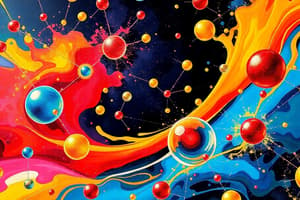Podcast
Questions and Answers
What type of intermolecular force arises in nonpolar molecules due to instantaneous, temporary, and fluctuating dipoles in the electron cloud?
What type of intermolecular force arises in nonpolar molecules due to instantaneous, temporary, and fluctuating dipoles in the electron cloud?
- Ionic bonding
- Dipole-dipole forces
- London dispersion forces (correct)
- Hydrogen bonding
Which intermolecular force involves the interaction between polar molecules with hydrogen atoms and electronegative atoms?
Which intermolecular force involves the interaction between polar molecules with hydrogen atoms and electronegative atoms?
- Dipole-dipole forces (correct)
- Ionic bonding
- London dispersion forces
- Metallic bonding
What is the primary cause for hydrogen bonding to occur between molecules?
What is the primary cause for hydrogen bonding to occur between molecules?
- Unequal distribution of electrons
- Presence of hydrogen atoms and electronegative atoms (correct)
- Presence of van der Waals forces
- Electron sharing
Which intermolecular force is responsible for the physical properties like boiling points and melting points of substances?
Which intermolecular force is responsible for the physical properties like boiling points and melting points of substances?
What type of force arises due to the partial positive and negative charges in polar molecules?
What type of force arises due to the partial positive and negative charges in polar molecules?
What type of forces are crucial in determining the properties of water and other hydrogen-bonded substances?
What type of forces are crucial in determining the properties of water and other hydrogen-bonded substances?
Which intermolecular force is responsible for binding ions in ionic crystals and salts?
Which intermolecular force is responsible for binding ions in ionic crystals and salts?
Why do substances with stronger hydrogen bonds and ionic forces tend to form more stable solids?
Why do substances with stronger hydrogen bonds and ionic forces tend to form more stable solids?
At higher temperatures, what happens to intermolecular forces like hydrogen bonds and ionic forces?
At higher temperatures, what happens to intermolecular forces like hydrogen bonds and ionic forces?
Which model provides a framework for understanding intermolecular forces by illustrating interactions between molecules?
Which model provides a framework for understanding intermolecular forces by illustrating interactions between molecules?
Study Notes
Unpacking Intermolecular Forces in Matter: The Kinetic Molecular Model
The world of matter is shaped by the intricate dance between atoms and molecules, governed by the forces that bind them together. At the heart of these interactions lie intermolecular forces, which form the foundation for our understanding of chemical properties and the behavior of matter.
Intermolecular forces are the weak attractions that develop between neighboring molecules. They are responsible for the cohesion and adhesion of matter, influencing the physical properties of substances such as boiling points, melting points, and surface tension. These forces can be divided into four primary types:
-
Dipole-dipole forces are the result of the partial positive and negative charges that arise in polar molecules due to the unequal distribution of electrons. When two polar molecules are brought close together, their respective dipoles interact, resulting in an attractive force.
-
London dispersion forces, also known as van der Waals forces, are the attractive interactions between nonpolar molecules. They arise from instantaneous, temporary, and fluctuating dipoles in the electron cloud of nonpolar molecules, resulting in weak yet significant forces between nonpolar molecules.
-
Hydrogen bonding is a unique type of intermolecular force that forms between polar molecules containing hydrogen atoms and electronegative atoms such as nitrogen, oxygen, and fluorine. Hydrogen bonds are stronger than dipole-dipole forces and are crucial in determining the properties of water and other hydrogen-bonded substances.
-
Ionic forces are the electrical attractions between oppositely charged ions. These strong forces bind ions in ionic crystals and salts, giving them unique properties such as high melting points, high boiling points, and good electrical conductivity.
The strength of these intermolecular forces plays a crucial role in determining the phase of matter. At low temperatures, weak van der Waals forces favor the formation of solids, while stronger hydrogen bonds and ionic forces result in more stable solids like ice and table salt. At higher temperatures, these forces are overcome, causing matter to transition into liquid or gas phases.
Understanding intermolecular forces is fundamental to the study of chemistry, as they influence the properties of substances, the behavior of mixtures, and the design of materials with specific properties. The kinetic molecular model, which visualizes the motion of particles in a system, provides a framework for understanding these forces by illustrating the interactions between molecules and the effects they have on matter.
With the advent of new features like the "No Search" function in Bing Chat, we are presented with the opportunity to explore these concepts without the burden of external information sources. Through self-directed learning and experimentation, it is possible to deepen our understanding of intermolecular forces and the kinetic molecular model, laying a strong foundation for a deeper appreciation of the intricacies of the physical world.
Studying That Suits You
Use AI to generate personalized quizzes and flashcards to suit your learning preferences.
Description
Explore the intricacies of intermolecular forces and the kinetic molecular model, delving into the fundamental interactions between atoms and molecules that shape the properties and behavior of matter. Learn about dipole-dipole forces, London dispersion forces, hydrogen bonding, and ionic forces, and how they influence the phase transitions of substances.




